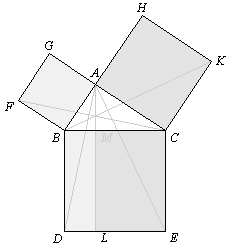Using the text of Sir Thomas Heath's translation of The Elements, I have graphically glossed Books I - IV to produce a reader friendly version of Euclid's Plane Geometry. The four books contain 115 propositions which are logically developed from five postulates and five common notions. In the first proposition, Proposition 1, Book I, Euclid shows that, using only the postulates and common notions, it is possible to construct an equilateral triangle on a given straight line. In the hundred fifteenth proposition, Proposition 16, Book IV, he shows that it is possible to inscribe a regular 15-gon in a circle. And along the way he develops many beautiful, interesting, captivating, and pleasing results. You are invited to read this part of one of the world's great books.
This presentation grew out of material developed for a mathematics course, Ideas in Mathematics, offered for liberal arts students at Furman. Every interested person, ninth grade student to ninety year old retiree, should be able to read most, if not all, of the material; that is the intended audience.
After reading the postulates and common notions (which, if you followed the link above, you have already done) you are ready to begin Book 1. I suggest that you consult the definitions only when you feel a need to do so. Since you probably know or will believe many of the results that Euclid develops, it is not necessary to read The Elements proposition after proposition. For this reason several reading sequences are given below. At times it may be helpful to read the statements (and first page restatements) of intervening propositions.
Suggested Reading Sequences
- Note: To begin reading a sequence of propositions, click on Begin Sequence. That takes you to the first proposition in the sequence. On the last page of the proof of the first proposition you will find a link to the next proposition in the sequence (Seq.# Next: Book#.Proposition#) and, finally, on the last page of the proof of the last proposition in the sequence there is a link to return you to this page (Contents and Introduction).
- 1. Book I, Propositions 1,2,3, and 4. Begin Sequence
- This sequence demonstrates the developmental nature of mathematics. Using the postulates and common notions, Euclid, with an ingenious construction in Proposition 2, soon verifies the important side-angle-side congruence relation (Proposition 4).
- 2. Book I, Propositions 9,10,15,16,27, and Proposition 29 through pg.3 of the proof. Begin Sequence
- Euclid uses the method of proof by contradiction to obtain Propositions 27 and 29. He uses Postulate 5 (the parallel postulate) for the first time in his proof of Proposition 29. Proposition 16 is an interesting result which is refined in Proposition 32.
- 3. Book I, Propositions 22,23,31, and 32. Begin Sequence
- To prove Proposition 32 (the interior angles of a triangle add to two right angles and an exterior angle is equal to the sum of the opposite and interior angles) one must be able to construct a line parallel to a given line. Thus, Propositions 22, 23, and 31 are included here.
-
- 4. Book I, Propositions 35,36,37,38,41, and 47. Begin Sequence
- Be sure to read the statement of Proposition 34. This sequence of propositions deals with area and terminates with Euclid's elegant proof of the Pythagorean Theorem (Proposition 47).
- 5. Book IV, Propositions 1,3,4, and 5. Begin Sequence
- This set of four propositions are now accessible to the reader and provide a good introduction to the constructions of Book IV.
- 6. Book I, Propositions 42,43,44,45, and Book II, Propositions 5 and 14. Begin Sequence
- Propositions 42,43,44 lead to Proposition 45 (I.45). I.45 and II.5[(a+b)(a-b)+b2=a2 or its equivalent (a+b)(a-b)=a2-b2] are used to prove II.14. A little effort to use algebra should give you an interesting contrast to Euclid's geometric argument.
- 7. Book III, Propositions 20,21,22,31(through pg.3 of the proof),32, and Book IV, Proposition 2. Begin Sequence
- This sequence is a joy to read; its development rests firmly on Proposition 32 of Book I. Begin by reading the statement of Proposition 2, Book IV, and the definition of segment of a circle given in Book III. Then proceed and be delighted.
- 8. Book II, Proposition 6 and 11, and Book IV, Propositions 10 and 11. Begin Sequence
- The reading now becomes a bit more intense but you will be rewarded by the proof of Proposition 11, Book IV. In order to read the proof of Proposition 10 of Book IV you need to know the result of Proposition 37, Book III. I suggest that you read the first page of the proof of each of Propositions 36 and 37 (and these results are not obvious ones). II.6, a geometric version of (2a+b)b+a2=(a+b)2, is used to obtain II.11 which has algebraic form: Find the positive number x, x<a, such that a(a-x)=x2. The 72, 72, 36 (degree measure) isosceles triangle constructed in IV.10 (and if you believe that can be done go straight to IV.11) is used to inscribe a regular pentagon in a circle, Proposition 11, Book IV.
- 9. Book III, Propositions 16,17,18, and Book III, Propositions 36 and 37. Begin Sequence
- It's about time for me to let you browse on your own. If you do read this final sequence, you will fill the void left in Sequence 8 and also see some experimental algebraic help in the presentation of Proposition 36.
|

